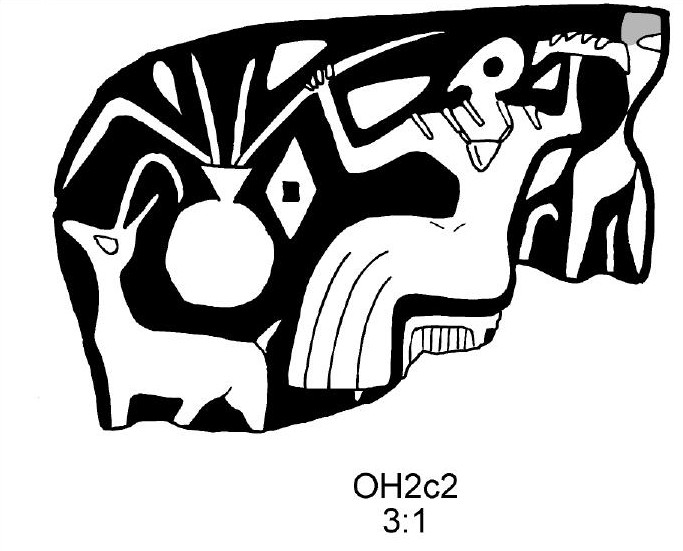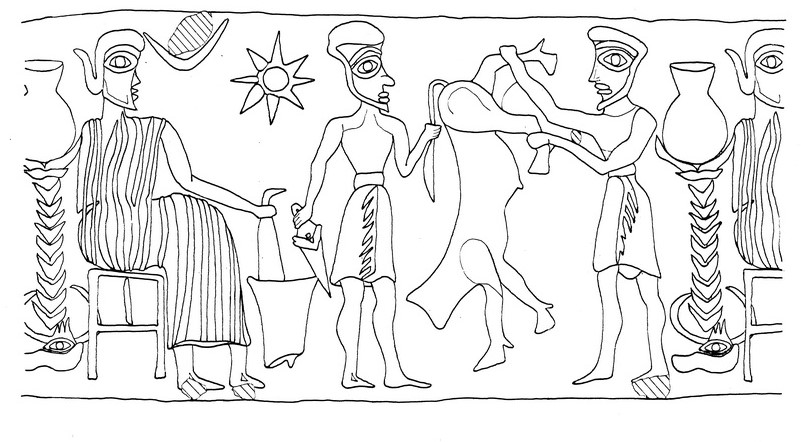Back to top: Main shapes
Introduction
The method for determining the shape categories in the Urkesh corpus is based on the method of access to the contents of the vessels. That is, the means usually employed to access vessel content, not an extraordinary usage. With such large data bases the rim diameters in most cases form a continuum. While there are a number of statistical methods for determining divisions in the sizes, the size divisions here are intuitively based with the addition of observations of the shape, size and use of the containers in local households. The size data used here come from two areas of the excavations, A14 and A16. In general the method of access to the contents of the vessels is the means usually employed and not an extraordinary usage. Obviously with some ingenuity vessels can be accessed in other ways than pouring or scooping but this would occur rarely. So for instance we can see in the seal impressions that wide bodied jars can be used for drinking with straws. In the case of the Urkesh ritual scene on a cylinder seal from A15 a jar is placed on top of a palm column; this vessel may have never been used as a container but rather a symbol important for the ritual. These examples are rare and have a special meaning not envisioned in the work of most potters.
Jars, bowls, plates, cups and pots are the most common shapes at Urkesh. Other main shapes like casseroles, bottles, pitchers, strainers and stands occur rarely, but often enough to merit a specific shape code.
Unusual uses of vessels:

|

|
ED III seal impression showing a figure drinking from jar using a straw |
Akkadian seal with a ritual scene that includes a jar placed on top of a palm column
|
Further definitions and a full list of possible shapes can be found in the Lexicon.
Back to top: Main shapes
Bowls
Open form with rim diameter wider than height. Most activities connected with this form will access the contents by pouring or scooping, depending on the size. Except for bowls in the smallest range, most bowls would be intended to be held or carried in two hands, particularly when full.
Although the rim diameters range along a continuum, the sizes have been intuitively divided. Little bowls have a rim diameter less than 10 cm. Small bowls between 10 and 15 cm. Medium bowls between 15 and 30 cm. In the category of large bowls the shapes are mostly deep bowls as shallow vessels with a wide rim are called platters in our system, these bowls range from 30 to greater than 50 cm.
See extensive list of examples in the Cross-horizon typology: bowls.
Back to top: Main shapes
Jars
Jar shapes have a rim diameter narrower than the height. Jar diameters range from little with a diameter of less than 10 cm, small with diameters between 10 and 14 cm, medium with a diameter range between 15-20 cm, and large with diameters between 21 and more than 50 cm. The greatest number of vessels in this large range have diameters between 21 and 30 cm. A large class of jars is defined as having a neck with its diameter smaller than the rim diameter; because of the neck constriction most of these necked jars can only have their contents poured out. While rim diameters of necked jars can range from less than 10 cm to greater than 50 cm, by far the largest number fall between 10 and 20 cm in diameter.
Most jars would have to be carried with two hands, particularly when full. Some small jars may have been small enough to hold in one hand, but the majority of jars are outside this size range. Jars are usually designed for pouring out the contents. Very large storage jars were obviously not meant to be moved and would have had their contents scooped out rather than poured out.
See extensive list of examples in the Cross-horizon typology: jars.
Back to top: Main shapes
Pots
Pots are defined in the Urkesh system as vessels with rim diameters about the same as their height. In most cases they do not have constrictions in the shape of the body of a vastly different diameter than the rim or height so that their essential geometric shape is a square. Pots are either small (less than 10 cm diameter) or within the the 10-20 cm range. Some pots have attached spouts.
See extensive list of examples in the Cross-horizon typology: pots.
Back to top: Main shapes
Cups
Cup shape vessels usually have a narrower rim diameter than height and can be held in one hand, even when full. The most common diameters are 10-12 cm although the diameters can range continuously from 4 cm to larger than 16 cm. Conical cups that are characterized as having straight sides and a string cut base are the most prevalent cup shapes.
See extensive list of examples in the Cross-horizon typology: cups.
Back to top: Main shapes
Plates and Platters
Plates and platters are very flat bowls in that their rim diameters are wider than their height, and in this case the rim diameters are very much wider than the height resulting in very shallow vessels. Plates have a diameter of less than 30 cm, while platters are larger and have diameters over 30 cm.
See extensive list of examples in the Cross-horizon typology: plates.
Back to top: Main shapes
Casseroles
Casseroles are exclusive to the Late Chalcolithic period. They have a distinctive caranation halfway down the body. Like bowls they are generally wider than they are tall. Generally the rim diameters fall between 15 and 25cms.
See extensive list of examples in the Cross-horizon typology: casseroles.
Back to top: Main shapes
Bottles
Bottles are generally quite small, with rim diameters usually less than 10cm. They have neck diameters that are narrower than the rim.
See extensive list of examples in the Cross-horizon typology: bottles.
Back to top: Main shapes
Pitchers
Pitchers are jars with a single handle near the rim large enough to hold and use for tipping the vessel to pour out the contents.
See extensive list of examples in the Cross-horizon typology: pitchers.
Back to top: Main shapes
Strainers
Strainers usually have the same formal shape as bowls, but a there is a significant difference in that strainers have holes pierced all the way through in the lower part of the vessel. The contents were thus not scooped or poured out, but rather poured through the vessel. They can act as filters, or strainers, as the name indicates.
See extensive list of examples in the Cross-horizon typology: strainers.
Back to top: Main shapes
Stands
Stands are open at both top and bottom. Overall they have a cylindrical shape with a range of heights and diameters depending on intended use. The body is curved to create wider base and rim than the body.
See extensive list of examples in the Cross-horizon typology: stands.
Back to top: Main shapes
Worked Disk/Stopper
Worked disks are body sherds that have been worked or chipped away into a circular shape. Worked disks can sometimes have visible wear marks that show use from a scraping motion. Stoppers are more shaped than worked disks and can be intentionally made (i.e. not a reworked sherd) and are sometimes unbaked. The unbaked examples can have impressions from the rims of vessels they were used on.
Back to top: Main shapes
Other
Other vessels encompasses those that do not neatly conform to the categories as described above. These types are relatively rare.
The known types are illustrated in the other cross-horizon page.
Back to top: Main shapes